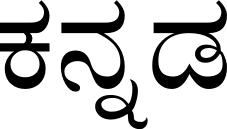Language/Kannada/Grammar/Adjectives
Hi Kannada learners! 😊
In this lesson, we will learn about adjectives in Kannada. Adjectives are words that describe or modify a person, place, thing or an idea. Adjectives add more detail and information to a sentence. They are like spices that add flavor to a dish.
Don't hesitate to look into these other pages after completing this lesson: Kannada Grammar → Consonants, Vowels: Pronunciation and Writing, Prepositions & Give your Opinion.
Types of Adjectives[edit | edit source]
In Kannada, adjectives can be divided into three types:
1. கூட்டு வினை வார்த்தை (kootu vinai vaarthai) - Compound Adjectives 2. செதுக்களான (chedukkaLaana) - Qualitative Adjectives 3. எண்ணாக்கள் (ennaakkal) - Quantitative Adjectives
Compound Adjectives[edit | edit source]
Compound adjectives are formed by combining two or more words to make a new word. In Kannada, compound adjectives usually consist of two nouns or an adjective and a noun. Here are some examples:
| Kannada | English |
|---|---|
| ಮಣ್ಣುಪಾದ (manNu paada) | muddy feet |
| ಕರುಣಾಪೂರ್ಣ (karuNaapUrNa) | full of compassion |
| ಗಟ್ಟಿಮೂಟಿ (gaTTimooTi) | strongly built |
| ಅಂಡಭೆಸ್ತನ (andha bhestana) | slow walker |
Qualitative Adjectives[edit | edit source]
Qualitative adjectives describe the quality or nature of a person, place, thing or idea. They give more details about the noun they are describing. Here are some examples:
| Kannada | English |
|---|---|
| ರಂಗವಾಣ (raNgavANa) | colorful |
| ಶಾಂತವಾದ (shaaMta vaaDa) | peaceful |
| ಬುದ್ಧಿವಂತ (buddhivanta) | intelligent |
| ಕಠಿಣ (katthiNa) | difficult |
Quantitative Adjectives[edit | edit source]
Quantitative adjectives describe the quantity of a noun. They answer the questions "how many?" or "how much?". Here are some examples:
| Kannada | English |
|---|---|
| ಏನುವಿಷಯದ (enu vishayada) | of what matter |
| ಕೆಲವು (kelavu) | some / few |
| ಅನೇಕ (aneka) | many / several |
| ಪುಷ್ಟ (pushTa) | healthy |
Adjective Forms[edit | edit source]
Adjectives in Kannada change their form based on the gender, number, and case of the noun they are describing. Here are some examples with the Kannada word for "beautiful" (ಸುಂದರ - suMdara):
| Kannada | English |
|---|---|
| ಸುಂದರ (suMdara) | beautiful (masculine singular) |
| ಸುಂದರಳ (suMdaraLa) | beautiful (feminine singular) |
| ಸುಂದರಮ್ (suMdaram) | beautiful (masculine plural) |
| ಸುಂದರೆಗಳು (suMdarEgaLu) | beautiful (feminine plural) |
Adjectives Agreement With Nouns[edit | edit source]
Adjectives in Kannada have to agree in gender, number, and case with the noun they are describing. Here is an example of how adjectives agree in gender:
- Masculine singular noun: ಸುಂದರ ಮಹಿಳೆ (suMdara mahiLe) - beautiful woman
- Feminine singular noun: ಸುಂದರಳ ಮಗಳು (suMdaraLa magaLu) - beautiful daughter
Here is an example of how adjectives agree in number:
- Singular noun: ಸುಂದರ ಮನೆ (suMdara mane) - beautiful house
- Plural noun: ಸುಂದರಮ್ ಮನೆಗಳು (suMdaram maneGaLu) - beautiful houses
Here is an example of how adjectives agree in case:
- Nominative case: ಸುಂದರ ಮಲ್ಲ (suMdara malli) - beautiful jasmine
- Accusative case: ಸುಂದರವಾದ ಮಲ್ಲಿಗೆ (suNdara vaaDa mallige) - to the beautiful jasmine
Dialogue[edit | edit source]
Here is a dialogue to help you understand how adjectives are used in Kannada:
- Person 1: ನೀನು ಯಾರಿಂದ ಬಂದಿದ್ದೀ? (nInu yaarinda baNdidde?) - Where are you from?
- Person 2: ನಾನು ಸುಂದರ ಊರ ಹುಟ್ಟಿದವನು (naanu suNdara oora huTTidavanu) - I am from a beautiful village.
Conclusion[edit | edit source]
In this lesson, we learned about the different types of adjectives in Kannada and how they are used to describe nouns. We also learned how adjectives agree in gender, number, and case with the nouns they are describing. To improve your Kannada Grammar, you can also use the Polyglot Club website. Find native speakers and ask them any questions! Don't forget to check out the Kannada grammar section on Polyglot Club for more resources. 😊
➡ If you have any questions, please ask them in the comments section below.
➡ Feel free to edit this wiki page if you think it can be improved. 😎
Well done on mastering this lesson! Don't miss these related pages to expand your knowledge: Negation, Learn about Kannada Grammar Conjuncts with a Kannada ..., Conditional Mood & How to Use Be.
Videos[edit | edit source]
Parts of Speech Part 4 - Adjectives | Explained in Kannada - YouTube[edit | edit source]
Other Lessons[edit | edit source]
- How to Use Have
- Gender
- Negation
- Give your Opinion
- Questions
- Conditional Mood
- How to Use Be
- Pronouns
- Nouns
Sources[edit | edit source]

